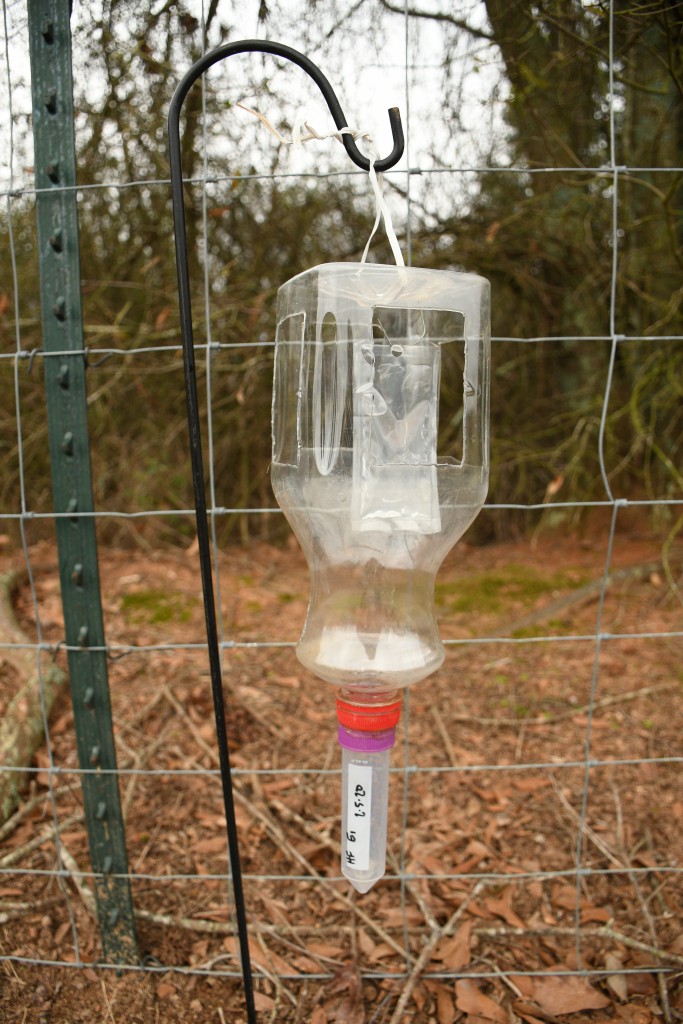Written By: Emily Cabrera
Expert Sources: Angel Acebes-Doria, Brett Blaauw, Shimat Joseph, and Will Hudson, Extension entomologists

Early Monitoring
If you are a pecan grower, monitoring efforts for ambrosia beetle should begin now, especially if you are planting new trees or have trees less than three years in your orchard. Young trees are at particular risk because they are coming out of dormancy using only what small carbohydrate reserves they have to put out new leaves, making them stressed and vulnerable to this pest.
Ambrosia beetles, primarily Xylosandrus crassiusculus (Mot.), X. germanus and other related species, are a tiny beetle in the weevil family that attacks stressed and dead trees by boring into the heartwood of trees where they excavate tunnels in order to cultivate fungal gardens, their sole source of nutrition.

Spring flight of this pest happens in the space of about two to three weeks when temperatures are more consistent. So, as temperatures warm, University of Georgia Extension specialists advise monitoring for this pest early because management will need to take place as soon as growers see evidence of beetles in their orchards.
“Growers should also pay close attention to areas that are poorly drained, because trees will more likely be stressed in those areas, making them vulnerable to attack,” said University of Georgia pecan entomologist Angel Acebes-Doria. “Although trees can recover from attacks by these beetles, the higher the attack – the more likely the trees could die,” she explained.
New adaptations of previous ambrosia beetle traps have been designed to allow growers a method of identifying when ambrosia beetles are attacking trees. The traps are called bolt – or log traps and are made using freshly cut segments of young trees that have been bored out and filled with ethanol or ethyl alcohol. They are hung about a meter off the ground and placed between orchards and the surrounding forested areas.
Ambrosia beetles coming out of dormancy will start to move into the orchard, so the traps will ideally get hit first, allowing for rapid identification and action on the grower’s part.

Bottle traps are another tool for monitoring the presence of ambrosia beetle in orchards. They are helpful for monitoring the timing of emergence and population density of this pest, but “just because you see ambrosia beetles in traps does not mean they are actively boring into trees,” said Acebes-Doria.

“The beauty of using log traps is that when ambrosia beetles bore into the wood, they create visible holes and the tell-tale sawdust ‘toothpicks’ so growers can immediately see if this pest is actively attacking trees, helping them make more informed management decisions.”

Management
Acebes-Doria suggests that if growers find beetles in their traps, they will want to initiate scouting for attacks on vulnerable trees and begin management using pyrethroid materials sprayed on trunks of infested trees and re-apply after 7-10 days – if needed.
“Growers often ask if they can use a systemic insecticide, but because these beetles are not actually ingesting the plant tissues, these types of insecticides don’t work,” explained Acebes-Doria. “For that reason, we recommend using a contact application of pyrethroids on the trunks of trees – as more of a preventative than a curative treatment.” Once the beetles make their way inside the wood, they are difficult to control.
“But I don’t want people to think they should just go out and spray insecticides without knowing for sure they have this pest in their system, and that their trees are being attacked. That is costly and unnecessary,” said Acebes-Doria.
Ongoing Research
This monitoring program is part of a larger collaborative project between researchers from Georgia, Tennessee, North Carolina, South Carolina, Virginia, Ohio, and New York. The working group is funded through the Southern IPM Center and meets annually to provide updates on monitoring and impact of this pest in various production systems in order to develop and assess priorities year after year.
“A lot of the previous research on ambrosia beetles has been done in ornamental production systems, but in the last couple years, there have been increased issues with this pest in apple and pecan systems,” said Acebes-Doria. “This pest has an incredibly wide host range, and is economically significant to several commodities, so the collaborative work we’re doing expands the research of this pest into multiple production systems and regions.”
Acebes-Doria and other researchers are in the planning phase of seeking continued funding to help further these and future research efforts. Their hope is to find more efficient ways of reporting trap captures online so agents and growers can stay apprised of how this pest is behaving each year – so stay tuned.
For additional information on pecans, visit the UGA Pecan Extension blog. And check out Extension Bulletin 1160 for more information on Ambrosia Beetles.